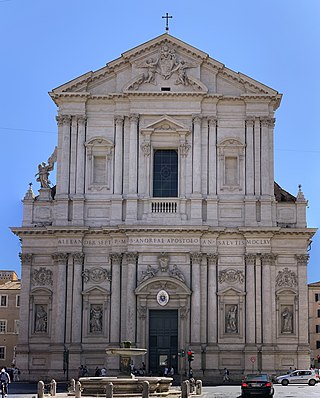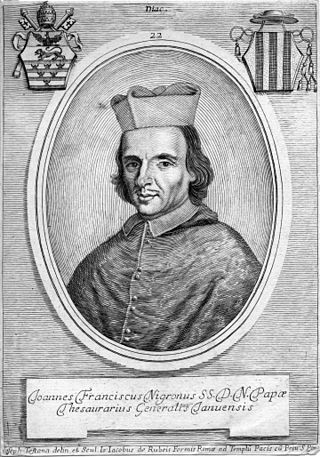Description
The church has a Greek-cross plan, with a dome overlapped to a high lantern. The portal, of mannerist style, dates back to 1606. The papal legate, cardinal Bonifacio Bevilacqua (who joined the brotherhood in 1601), ordered the imposing portal (1604) and he is reminded in the inscription above. The weapons here are those of Pope Clement VIII, the cardinal Bevilacqua and the vice-legate Alessandro Maggi, with the griffin of Perugia under the inscription, [3] it's surmounted with a trabeation that recalls the doric decoration of the Arco Etrusco: a frieze composed by metope with round shields the clipei and triglyphs. [4]
The inside of the church has a square plan with a rectangular tribune and two rectangular lateral chapels. Above the entrance there is a balaustrade choir. The organ (1897) was built by Nicolò and Francesco Morettini. Renovated in the XVIII century keeps paintings and stuccoes of Francesco Busti, Cristoforo Gasperi and Anton Maria Garbi (XVIII century). On the main altar stands a painting of Vincenzo Pellegrini representing "Ognisanti" – All Saints (1612) inserted in a golden and carved architectural frame. [5]

Alcamo is the fourth-largest town and commune of the Province of Trapani, Sicily, with a population of 44.925 inhabitants. It is on the borderline with the Metropolitan City of Palermo at a distance of about 50 kilometres from Palermo and Trapani.

Perugia is the capital city of Umbria in central Italy, crossed by the River Tiber. The city is located about 164 km (102 mi) north of Rome and 148 km (92 mi) southeast of Florence. It covers a high hilltop and part of the valleys around the area.

Sant'Andrea della Valle is a minor basilica in the rione of Sant'Eustachio of the city of Rome, Italy. The basilica is the general seat for the religious order of the Theatines. It is located at Piazza Vidoni, at the intersection of Corso Vittorio Emanuele and Corso Rinascimento.

Ventura di Archangelo Salimbeni was an Italian Counter-Maniera painter and printmaker highly influenced by the vaghezza and sensual reform of Federico Barocci.

The Church of Our Lady of the Rosary, Asmara is a Catholic church built in the early 1920s in Asmara, when the city was the capital of Italian Eritrea. Often called "the cathedral", it is a large Lombard Romanesque style church in the centre of the city, built in 1923 to serve as the principal church of the Apostolic Vicariate of Eritrea.

Bonifazio Bevilacqua Aldobrandini was an Italian Cardinal. He was the uncle of Pope Gregory XIV.

The Via Giulia is a street of historical and architectural importance in Rome, Italy, which runs along the left (east) bank of the Tiber from Piazza San Vincenzo Pallotti, near Ponte Sisto, to Piazza dell'Oro. It is about 1 kilometre long and connects the Regola and Ponte Rioni.

Santa Maria della Scala is a titular church in Rome, Italy, located in the Trastevere rione. Cardinal Ernest Simoni took possession of the titular church on 11 February 2017. Santa Maria della Scala is a titular church.

Santa Maria dell'Orazione e Morte is a church in central Rome, Italy. It lies on Via Giulia between the Tiber and the Palazzo Farnese.

Santa Caterina dei Funari is a church in Rome in Italy, in the rione of Sant'Angelo. The church is mainly known for its façade and its interior with frescoes and paintings.

The Archdiocese of Perugia-Città della Pieve is a Latin archdiocese of the Catholic Church. It was historically the Diocese of Perugia. It became the Archdiocese of Perugia in 1882, but without suffragans. It acquired suffragan dioceses in 1972. It was united in 1986 with the Diocese of Città della Pieve.

Santa Maria del Carmine is a church in Pavia, Lombardy, northern Italy, considered amongst the best examples of Lombard Gothic architecture. It was begun in 1374 by Gian Galeazzo Visconti, Duke of Milan, on a project attributed to Bernardo da Venezia. The construction followed a slow pace, and was restarted in 1432, being finished in 1461.

Benedetto Pamphili was an Italian cardinal, patron of the arts and librettist for many composers.

Francesco Mancini was an Italian painter whose works are known between 1719 and 1756. He was the pupil of Carlo Cignani.

Fulvio Giulio della Corgna was a Tuscan Catholic bishop and cardinal.

San Francesco d'Assisi is a 16th-century-style church dedicated to Saint Francis of Assisi, located in Alcamo, province of Trapani, Sicily, southern Italy.

The Chiesa del Gesù is a Catholic church located in Alcamo, in the province of Trapani, Sicily, southern Italy. It is the second largest church in Alcamo, after the basilica di Santa Maria Assunta.

Monsignor Vincenzo Regina was an Italian presbyter and historian.

San Filippo Neri is a deconsecrated church in Rome, important for historical and artistic reasons. The church, facing the Via Giulia, was built during the Baroque age. San Filippo was supposed to be demolished together with the surrounding neighborhood in the late 1930s, but due to the onset of WWII the demolition was halted. Abandoned and desecrated after the war, it has been restored in 2000, but maintains a secular usage and is not accessible.

Giovanni Francesco Negroni was a Catholic cardinal who served as Bishop of Faenza from 1687 to 1697, and as Legate of Bologna from 1687 to 1690.
This page is based on this
Wikipedia article Text is available under the
CC BY-SA 4.0 license; additional terms may apply.
Images, videos and audio are available under their respective licenses.





















